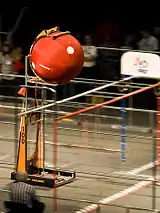Co-Opertition FIRST
Co-Opertition FIRST was the 2000 game for the FIRST Robotics Competition.
 | |
| Year | 2000 |
|---|---|
| Season Information | |
| Number of teams | 372[1] |
| Number of regionals | 10[2] |
| Championship location | Epcot Center, Disney World |
| Awards | |
| Chairman's Award winner | Team 16 - “Baxter Bomb Squad”[3] |
| Woodie Flowers Award winner | Kyle Hughes[4] |
| Founder's Award winner | Dr. William Murphy, Founder of Cordis Corporation & Small Parts, Inc.[4] |
| Champions | Team 255- "Foothill Robotics" Team 232 - "Vintage" Team 25 - "Raider Robotix"[4] |
Field
The playing field was a carpeted, rectangular area with two 6 ft (2 m) high goals located midfield, one goal for each alliance. There is a 30 in (762 mm) clearance bar under each goal. Between the goals is an 8 ft (2 m) wide ramp with a 5 ft (2 m) clearance bar, which robots may hang on to score points. Around the perimeter of the field are four stations for human players, who work with remote controlled robots on the field to score points. At the start of each match, each alliance station contains seven yellow balls and one black ball. Fifteen yellow balls and two black balls are located at the far end of the playing field.[5]
Robots
Each robot can weigh up to 130 lb (59 kg), and must start each match small enough to fit inside a 30" x 36" x 5' space. The robots are powered by a sealed lead-acid battery from Yuasa Exide, Inc. and use motors from S-B Power Tool Company, ITT Automotive, Keyang, Globe Motor, and Delphi Interior and Lighting. They also use speed controllers and a programmable control system supplied by FIRST. Drivers use joysticks from CH Products and switches from Honeywell to remotely control the robots via a radio link which uses RNet wireless modems from Motorola.
Scoring
Each match is two minutes long. Alliances receive one point for each yellow ball and five points for each black ball in their goal, and not in contact with their robot. Robots that are completely on the ramp each earn five points for their alliance. A robot hanging from the horizontal bar connecting the two goals earns ten points for its alliance.
"Co-Opertition"
The idea of Co-opertition stems from the games scoring for the qualifying matches. The winning alliance receives 3x the loser's score as their qualifying points. Thus, it is more beneficial to win a match 10-9 than 20–0.
Events

The following regional events were held in 2000:[6]
- Week 1
- Kennedy Space Center Southeast Regional - Kennedy Space Center, FL
- Great Lakes Regional - Eastern Michigan University, Ypsilanti, MI
- Week 2
- Johnson & Johnson Mid-Atlantic Regional - Rutgers University, New Brunswick, NJ
- NASA Langley/VCU Regional - Virginia Commonwealth University, Richmond, VA
- Lone Star Regional - Astro Arena Complex, Houston
- Week 3
- Philadelphia Alliance Regional - Drexel University, Philadelphia
- Motorola Midwest Regional - Northwestern University, Evanston, Il
- Long Island Regional - Suffolk County Community College, Long Island, NY
- Week 4
- UTC New England Regional - Meadows Music Theater, Hartford, CT
- NASA Ames Regional - San Jose State University, San Jose, CA
References
- "2006 Annual Report" (PDF). FIRST. Archived from the original (PDF) on 21 January 2013. Retrieved 16 September 2011.
- "2000 FIRST ROBOTICS COMPETITION SCHEDULE" (PDF). technokats.org. Archived from the original (PDF) on 21 March 2012. Retrieved 16 September 2011.
- "FIRST History". FIRST. Archived from the original on 8 December 2015. Retrieved 12 June 2011.
- "Results from the 2000 FIRST Robotics Competition" (PDF). technokats.org. Archived from the original (PDF) on 21 March 2012. Retrieved 16 September 2011.
- "The Game" (PDF). FIRST-A-HOLCS. Archived from the original (PDF) on 24 March 2012. Retrieved 1 June 2011.
- "2000 FIRST ROBOTICS COMPETITION SCHEDULE" (PDF). technokats.org. Archived from the original (PDF) on 21 March 2012. Retrieved 18 September 2011.
- "NATIONAL CHAMPIONS - 2000". Foothill Robotics. Archived from the original on 4 March 2016. Retrieved 31 May 2011.
